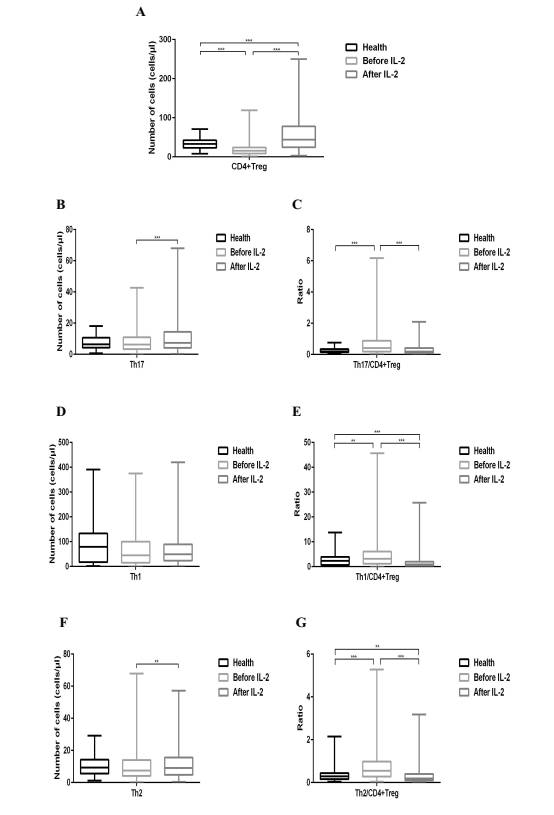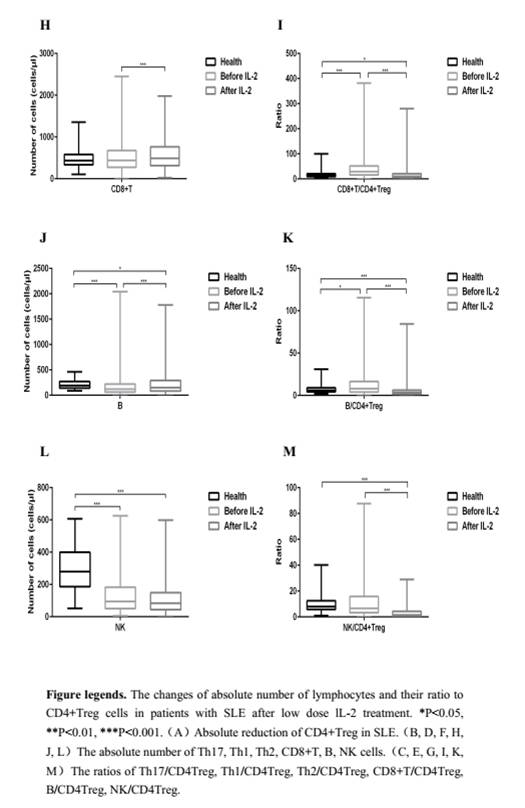Session Information
Date: Sunday, October 21, 2018
Title: T Cell Biology and Targets in Autoimmune and Inflammatory Disease Poster
Session Type: ACR Poster Session A
Session Time: 9:00AM-11:00AM
Background/Purpose: Regulatory T (Treg) cells, with the capacity to suppress immune responses, and effector T (Teff) cells, to promote inflammation, have been intensively studied in recent years. However, previous reports describing the respective changes of Treg and Teff, especially T helper 17 cells (Th17) in patients with systematic lupus erythematosus (SLE) were controversial. Here, we investigated the changes of both the absolute number and percentage of CD4+CD25+Foxp3+Treg (CD4Treg) and effector cells on a large scale and further the role of low-dose interleukin-2 (IL-2) on these changes in SLE.
Methods: A total of 235 SLE patients (219 women and 16 men), with mean age of 37.80¡À14.00 years, and 90 healthy volunteers, matched for patients¡¯ age and gender, were enrolled. The absolute number and percentage of subpopulation of peripheral blood (PB) lymphocyte in these patients were measured by flow cytometry combined with internal microsphere standard. And low-dose IL-2 was used among 127 patients at a dosage of 50 WIU every day for five days. Immunological and clinical assessments were performed again.
Results: As compared to healthy controls, the absolute number of CD4Treg were significantly decreased in SLE. The median ratios of Th17/Treg in patients were greatly higher than those of healthy volunteers [0.42(0.19, 0.88) vs. 0.21(0.15, 0.34), P<0.001], while there was not significantly different about Th17. Besides, Th1, Th2, CD8+T, B cells and their respective ratios to Treg were like that of Th17 as well. Moreover, CD4Treg cells were negatively correlated with ESR and SLEDAI score. While no obvious correlation was seen between Th17 cells and SLEDAI score. After IL-2 therapy in SLE, there was a four-fold increase in CD4Treg [43.73(24.08, 74.22) vs. 11.95(7.51, 20.34), P<0.001], whereas Th17 cells were increased slightly. The ratio of Th17/Treg was decreased significantly in patients with IL-2 treatment [0.19(0.09, 0.41) vs. 0.52(0.23, 0.95), P<0.001], tended to balance and had no difference with healthy individual (P=0.275). Similarly, there were same trends in Th1, Th2, CD8+T, B and NK cells.
Conclusion: The reduction of CD4Tregs, rather than the elevation of effector cells, contributes to the imbalance of Teff/Treg, indicating that SLE is an autoimmune disease triggered by the defect of immunotolerance. More importantly, although low-dose IL-2 might promote the proliferation of various lymphocyte subpopulation, it mainly modulated the abundance and immunosuppression activity of Tregs, which effectively induced autoimmune tolerance and further improved clinical symptoms.
To cite this abstract in AMA style:
Liu XQ, Lai NL, Duan Y, Chen J, Li XF, Gao C. Peripheral CD4+CD25+Foxp3+T Regulatory Cells Absolutely Reduce in Patients with Systemic Lupus Erythematosus [abstract]. Arthritis Rheumatol. 2018; 70 (suppl 9). https://acrabstracts.org/abstract/peripheral-cd4cd25foxp3t-regulatory-cells-absolutely-reduce-in-patients-with-systemic-lupus-erythematosus/. Accessed .« Back to 2018 ACR/ARHP Annual Meeting
ACR Meeting Abstracts - https://acrabstracts.org/abstract/peripheral-cd4cd25foxp3t-regulatory-cells-absolutely-reduce-in-patients-with-systemic-lupus-erythematosus/


